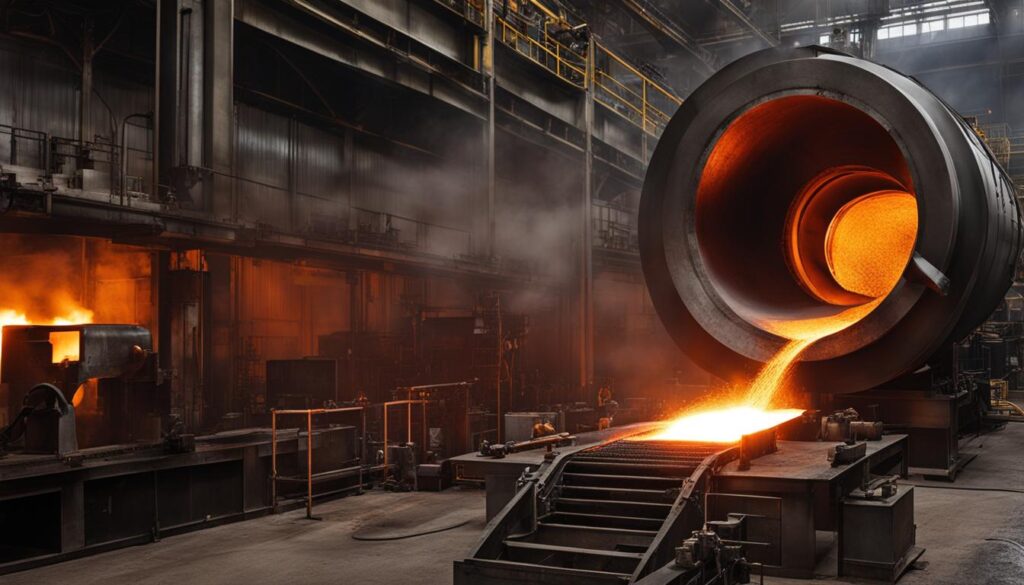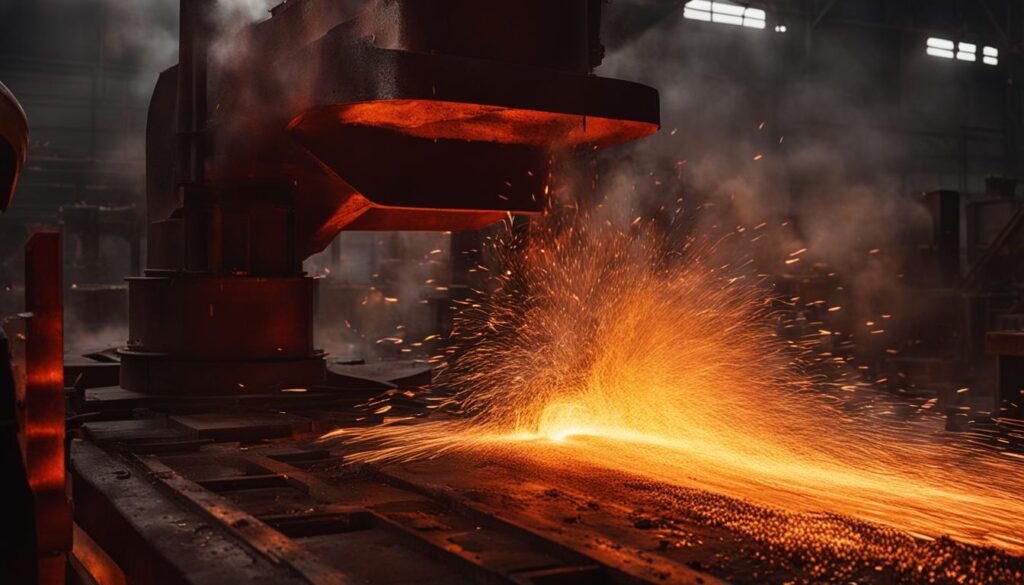At KT-Foundry, our expertise in metallurgy drives us to meticulously enhance the heat resistance of alloy steel castings, a core attribute imperative to their performance in high-temperature applications. Our pursuit is rooted in ensuring that industrial components exhibit exemplary industrial durability, capable of withstanding the rigors of extreme thermal stress. We recognize that the materials we deploy in challenging environments are not just about endurance but also about maintaining their structural integrity and function at elevated temperatures. This understanding compels us to delve deep into the science that fortifies our nickel-based superalloys, pushing the boundaries of what is possible with conventional steels.
Key Takeaways
- Nickel-based superalloys are essential for high-temperature resilience in industrial applications.
- Our alloys’ unique microstructure significantly influences their performance under thermal stress.
- Maintaining ductility along with strength at increased temperatures is a key attribute of our material solutions.
- Components such as aircraft engine turbines benefit greatly from the high-temperature capabilities of our castings.
- The evolution of superalloys with the incorporation of elements like aluminum ensures enhanced corrosion resistance.
- Heat treatments and operational stresses are considered to adapt and perfect our alloy’s high-temperature performance.
The Role of Nickel and Coatings in Enhancing the Heat Resistance of Alloy Steel Castings
As we delve into the metallurgical enhancement of alloy steel castings, it becomes clear that nickel-based superalloys and their surface treatments play a pivotal role. These materials have revolutionized the durability of industrial components, being synonymous with high-temperature resistance and reliability.
Nickel-Based Superalloys and Their Applications
Nickel-based superalloys have become the cornerstone for critical components that operate under extreme thermal stress. These superalloys are renowned for their ability to maintain their structural integrity, even when subjected to temperatures that would challenge conventional metals. Among their chief applications are aircraft engine turbines and industrial gas turbines (IGTs), where a metallurgical advantage is not just desired but demanded. The balance between phases within the alloy is key, with delicate micro-structures providing both resilience at soaring temperatures and essential ductility.
Advancements in Coating Methods for Alloy Steel
Advancements in surface technology have ushered in a new era for alloy steel preservation, particularly through the application of superalloy coatings. Chemical vapor deposition (CVD), a refined process designed to deposit coatings like chromium and aluminum onto steel surfaces, enormously boosts their oxidation-corrosion resistance. These high-performance coatings are particularly beneficial for industrial boilers and other high-volume applications where the steel components face challenging environments.

Combined Chromizing–Siliconizing Treatments for Optimal Resistance
Our commitment to extending the endurance of heat-resistant alloy coatings has led us to combine chromizing with siliconizing treatments. These dual processes make the most of the transformative properties of carbon steels and low-alloy steels at high temperatures. Such treatments effectively fend off high-temperature corrosion, carburization, and sulfidation, ensuring that the components attain a formidable surface layer while retaining the core’s unaltered strength and flexibility. It’s innovations like these that bolster our leadership in delivering state-of-the-art industrial components with unparalleled high-temperature and oxidation resistance.
Microstructural Evolution and Defect Analysis in High-Temperature Environments
At KT-Foundry, we prioritize the integrity of our alloy steel castings through meticulous microstructural investigation and defect analysis. Understanding the alloy macrostructure is foundational to our commitment to excellence in our field, particularly when addressing the complex requirements of high-temperature applications.
Macro and Microstructural Investigation Techniques
In order to ensure optimal alloy quality control, our engineers use a variety of techniques to inspect both macro and micro levels of our castings. This in-depth analysis is crucial for fulfilling stringent industrial standards and ensuring the long-term alloy stability of our products.
Identification and Impact of Defects in Alloy Steel Castings
We consider every aspect of solidification methods to minimize casting defects. Through advanced imaging and testing, we identify any imperfections such as inclusions or porosity, which could potentially undermine the robustness of our castings in their operational environment.

The Influence of Rafting Phenomenon on Alloy Stability
The rafting phenomena at high temperatures present a unique challenge to the stability of stress-resistant superalloys. By observing and regulating this coalescence of γ and γ′ phases, we ensure that the alloys we produce can withstand the harshest of service conditions with exceptional durability.
| Investigation Technique | Parameter Assessed | Importance to Alloy Quality |
|---|---|---|
| Count Method | Primary Dendrite Arm Spacing | Evaluates homogeneity and structural integrity |
| Secant Method | Secondary Dendrite Arm Spacing | Essential for understanding solidification characteristics |
| Nearest-Neighbor Method | Grain Orientation and Distribution | Crucial for predicting and improving high-temperature performance |
Conclusion
In the realm of heat-resistant alloys, the journey towards perfection is continuous and demanding. At KT-Foundry, we are immersed in the challenges presented by extreme environments and are proud to contribute to this critical field with our durable industrial materials. Our dedication to pushing the boundaries of cutting-edge metallurgy has enabled us to engineer nickel-based superalloys with unparalleled performance in high-temperature applications.
Our approach has always been holistic. We delve into the microstructural evolution with as much zeal as we focus on sophisticated defect analysis. This ensures each casting has a fortified resistance to thermal stress, underpinned by the quality only meticulous oversight can guarantee. Understanding and mitigating the influence of rafting has further solidified our alloys’ position as industry pinnacles in both stability and endurance.
We take immense pride in our work, knowing that it serves industries on the frontline of innovation, where reliability and longevity are not mere preferences but absolute necessities. Our heat-resistant alloys stand as testaments to the rigors of science and the exactitude of modern technology – designed not just to meet the stringent requirements of today’s industrial landscape but to surpass them with certainty.
FAQ
What makes alloy steel castings ideal for high-temperature applications?
Alloy steel castings are ideal for high-temperature applications due to their ability to resist extreme heat and maintain structural integrity. The addition of elements like nickel and aluminum increases their high-temperature resistance and industrial durability, making them suitable for environments that require reliable material performance under thermal stress.
How do nickel-based superalloys enhance the performance of industrial components?
Nickel-based superalloys enhance the performance of industrial components by providing exceptional corrosion resistance and the ability to withstand higher temperatures than traditional steels. They are particularly engineered to retain their strength and ductility at elevated temperatures, which is critical for components like aircraft engine turbines and industrial gas turbines.
What are the advancements in coating methods for increased heat resistance in alloy steel?
To increase the heat resistance of alloy steels, advancements in coating methods such as chemical vapor deposition (CVD) have been developed. These techniques allow for the deposition of chromium and aluminum on steel surfaces to enhance their oxidation and corrosion resistance, particularly in aggressive high-temperature environments.
How does the combined chromizing–siliconizing treatment benefit alloy steel castings?
The combined chromizing–siliconizing treatment benefits alloy steel castings by offering improved resistance to high-temperature corrosion, as well as protection against carburization and sulfidation. The treatment exploits the transformative properties of carbon and low-alloy steels under high temperatures, resulting in durable, strong surface layers while preserving the steel core’s integrity.
Why is macro and microstructural investigation important in the production of superalloys?
Macro and microstructural investigations are crucial in the production of superalloys because they help ensure the quality of alloy steel castings. These methods evaluate the spacing between dendrites and scrutinize structural constituents for consistency, contributing to defect prevention and the assurance of stability necessary for high-temperature applications.
What kinds of defects are typically identified in alloy steel castings, and how do they impact quality?
Typical defects in alloy steel castings include nonmetallic inclusions, porosity, shrinkage porosity, and cracks. Identifying and mitigating these defects are critical as they can detrimentally affect the performance and structural integrity of the castings. Quality control practices aim to achieve homogeneity and optimal crystal grain orientation to ensure superior high-temperature performance.
How does the rafting phenomenon influence the stability of alloy steel castings under high temperatures?
The rafting phenomenon impacts the stability of alloy steel castings under high temperatures by causing the directional coalescence of γ/γ′ phases under stress, which can significantly alter the mechanical properties of superalloys. By understanding and controlling this phenomenon, we ensure that the superalloys produced possess exceptional stress resistance in harsh thermal environments.


